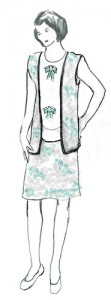My middle school daughter aspires to be a fashion designer, and so she’s been concentrating lately on learning to draw female human figures. Last Friday, she came home from school and immediately logged on to the internet in search of a “how to draw” tutorial. She spent the next several hours engrossed in aYouTube video that not only demonstrated how to draw the ideal human figure but offered some interesting tricks of the trade. For example:
- The ideal figure is eight heads tall.
- The width of this figure’s shoulders is typically two heads — arranged horizontally — wide.
- The width of this figure’s hips is typically two heads — arranged vertically — wide.
- The top of this figure’s inseam (or the “bend” of the figure) is four heads tall or half a person’s height.
That’s right! Your own body can be sketched based on the size of your head!
What does it have to do with math? This approach to drawing is based on proportions, and it depends on a relative unit. In other words, the entire figure can be drawn based on one relative measurement — the size of the figure’s head.
(Here’s an interesting video that shows how to draw these figures by first folding the page in half longways and then in eighths along the short side. Great use of proportions!)
This approach allows great flexibility. For example, men are typically taller than women, but their heads are also typically larger. Therefore, the unit for a male figure will probably be bigger than a unit for a female figure.
In addition, artists can use this one unit to draw figures of varying sizes — tiny in one drawing or huge in a large-scale piece — simply based on this one unit. All they need to do is draw the head first.

It’s important to note that no one has a perfectly proportioned body. Some people may be only 7.5 heads tall. Or perhaps their legs are not half their height. Or maybe they have a long waist. And the angle at which a figure is positioned will affect these proportions. Objects that are closer seem larger, while objects that are farther away seem smaller. This is called foreshortening.
And of course anything can be used as the unit measure. Have you ever seen an artist look at her subject over an outstretched brush or pencil? This is a common method of measuring the figure from that particular angle. An artist using the photograph to the left might notice, for example, that the subject’s right foot is three heads high.
The pencil or brush can also be useful in determining angles. Two pencils can be held up to form the angle made by the figure’s arm and torso and then checked against that angle in the drawing.
All of these techniques are based on the properties of similar figures. If two figures are similar, they have the same shape, but are proportional in size. Remember your geometry class, when you proved that two triangles were similar, using the SSS, SAS and ASA similarity theorems for triangles? (If not, don’t worry.) They boil down to one important fact: all of the corresponding sides of similar figures are proportional, while all of the angles of those figures are the same measure.
But here’s the thing: artists probably don’t think too much about that. My daughter hasn’t even studied similarity yet, but she’s able to figure out how to draw a human figure. Once again, we’re using math without knowing the reasons behind it. And that’s okay. It’s enough to know that it’s there.
Do you draw? Have you attempted to learn to draw but not understood how to get the proportions right? Does having some of these rules help?
